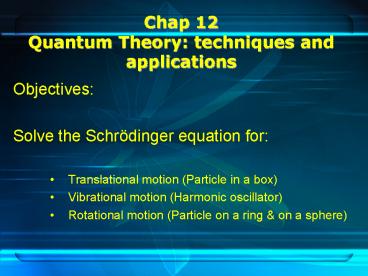Chap 12 Quantum Theory: techniques and applications PowerPoint PPT Presentation
1 / 19
Title: Chap 12 Quantum Theory: techniques and applications
1
Chap 12Quantum Theory techniques and
applications
- Objectives
- Solve the Schrödinger equation for
- Translational motion (Particle in a box)
- Vibrational motion (Harmonic oscillator)
- Rotational motion (Particle on a ring on a
sphere)
2
Rotational Motion in 2-D
Fig 9.27 Angular momentum of a particle of mass
m on a circular path of radius r in xy-plane.
Classically, angular momentum Jz mvr
pr and
Wheres the quantization?!
3
Fig 9.28 Two solutions of the Schrödinger
equation for a particle on a ring
- For an arbitrary ?, F is unacceptable not
single-valued - F 0 and 2p are identical
- Also destructive interference of F
This F is acceptable single-valued and
reproduces itself.
4
Acceptable wavefunction with allowed wavelengths
5
Apply de Broglie relationship Now Jz mvr
pr As weve seen Gives where ml
0, 1, 2, ... Finally
Magnetic quantum number!
6
Fig 9.29 Magnitude of angular moment for a
particle on a ring.
Right-hand Rule
7
Fig 9.30 Cylindrical coordinates z, r, and f.
For a particle on a ring, only r and f change
Lets solve the Schrödinger equation! ?
8
Fig 9.31 Real parts of the wavefunction for
a particle on a ring, only r and f change.
As ? decreases, ml increases in chunks of h
9
Fig 9.32 The basic ideas of the vector
representation of angular momentum
Vector orientation
Angular momentum and angle are complimentary (Can
t be determined simultaneously)
10
Fig 9.33 Probability density for a particle in a
definite state of angular momentum.
Probability ?? with
Gives
Location is completely indefinite!
11
Rotation in three-dimensions a particle on a
sphere
Schrodinger equation
Laplacian
Hamiltonian
V 0 for the particle and r is constant, so
By separation of variables
12
Fig 9.35 Spherical polar coordinates. For
particle on the surface, only ? and f change.
13
Fig 9.34 Wavefunction for particle on a sphere
must satisfy two boundary conditions
Therefore two quantum numbers l and
ml where l orbital angular momentum QN 0,
1, 2, and ml magnetic QN l, l-1,, -l
14
Table 9.3 The spherical harmonics Yl,ml(?,f)
15
Fig 9.36 Wavefunctions for particle on a sphere
Sign of ?
-
-
-
16
Fig 9.38 Space quantization of angular
momentum for l 2
Permitted values of ml
Because ml -l,...l, the orientation of
a rotating body is quantized!
?
Problem we know ?, so... we cant know f
17
Fig 9.39 The Stern-Gerlach experiment
confirmed space quantization (1921)
Classical expected
Observed
Ag
Inhomogeneous B field
Classically A rotating charged body has a
magnetic moment that can take any orientation.
Quantum mechanically Ag atoms have only two
spin orientations.
18
Fig 9.40 Space quantization of angular
momentum for l 2 where f is indeterminate.
?
19
(No Transcript)

